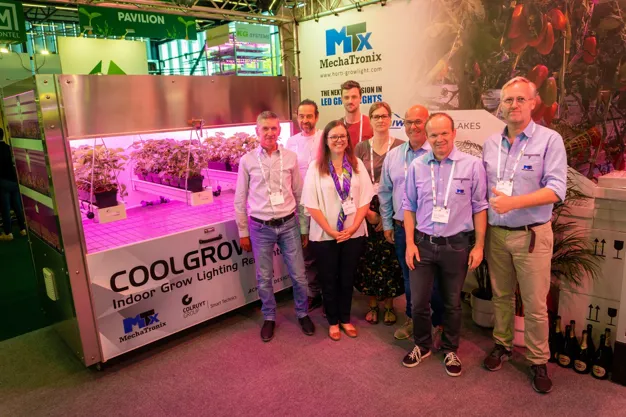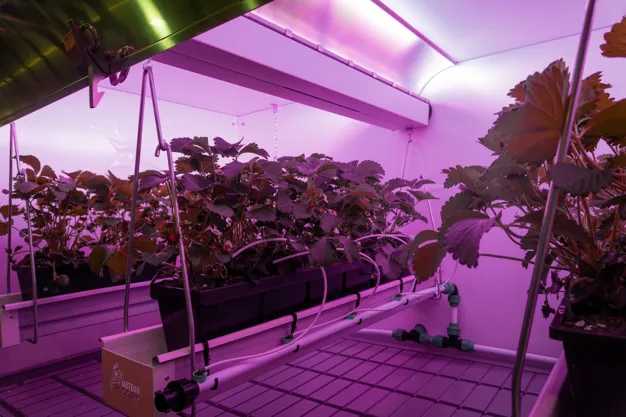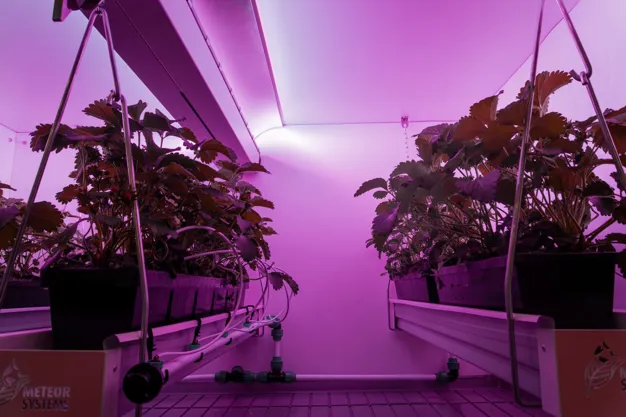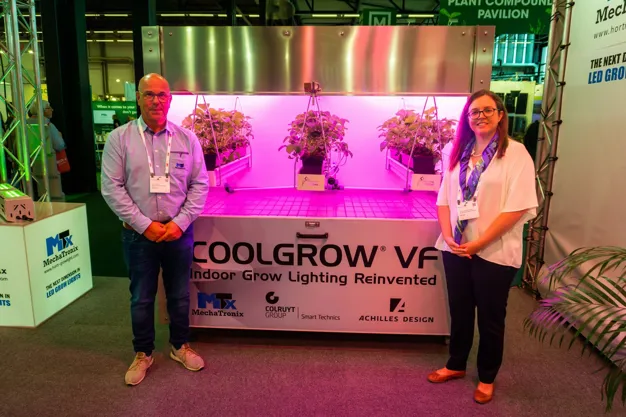At first glance, it looks like an ordinary vertical farm, which is what Koen Vangorp of MechaTronix and Kim Vancauwenberghe of Colruyt Group Smart Technics stand for. Strawberry plants, purple light, watering, and ventilation, meanwhile, all very ordinary. Yet there is more to it. The new CoolGrow CV VF was developed specifically with an eye on less energy consumption and more production. "We are convinced of the potential of vertical farming, but we also see that operational costs and installations need some changes to be sustainable," says Kim. "That's been achieved with the CoolGrow VF."
 The team behind the CoolGrow VF: Mechatronix, Colruyt Group, and Achilles Design
The team behind the CoolGrow VF: Mechatronix, Colruyt Group, and Achilles Design
Costs down, yield up
The profitability of vertical farms is under pressure. High energy consumption and relatively limited production figures mean that skeptics have already all but written off the idea of vertical farming as hobby projects for the happy few. And yet Colruyt Group sees the potential of vertical farming. A few years ago, the retailer was looking for a party to ensure that the costs of vertical farms would go down significantly and the yields up.
Contrary to what many people know, there is a broad concern, with a long tradition of productivity, behind the Colruyt Group supermarket chain. "And sustainability is one of the pillars we stand for as a whole company. That involves our stores, but also what we save beyond the store floor: Our packaging, our logistics solutions, energy management, and also our energy holding company Virya Energy, with which we develop renewable energy, for example. And then, we look even more for solutions on how to use this energy smartly and make the food chain more sustainable. That's how we ended up with vertical farms."

She emphasizes that Colruyt Group's goal is to make our food chain more sustainable together with growers, making available the necessary investments and access to land, but also certainly the latest techniques.
After collaboration with the Laboratory for Lighting Technology (KU Leuven-Ghent) and research in the market, they joined forces with MechaTronix, a producer and specialist of LED lighting for horticulture. In recent years, the Colruyt Group R&D department has worked hard on the concept together with Achilles Design. Now there stands the CoolGrow VF as a result - but what are we actually looking at?

Like the CoolGrow lamps, the installation is equipped with high-efficiency LEDs and a glass panel in an aluminum housing, but the LEDs spread their light over a highly reflective ceiling, allowing the light to diffuse completely into the vertical farm. At the same time, optimal use has been made of the physics of refraction and reflection of light.
By using the diffuse, highly reflective material on the inside of the vertical farm, the light coming from that one fixture is evenly distributed over the entire width of the vertical farm. As a result, the plants in the growing system benefit from maximum and fully diffused light coming from a single row of fixtures. "Moreover, the advantage of the installation is that the plant is exposed in places where there would otherwise be no light," says Koen Vangorp.

The installation has up to 10 times fewer exposure points per square meter. In addition, the plants also benefit from diffused light and thus start producing more. "So the savings are twofold," Kim demonstrates. "On the one hand, the initial investment goes down because far fewer lamps are needed: a 1200W fixture can illuminate a cultivation unit with a span of almost 5 square meters. To be precise, an area of 1.2m by 4.2m with one lamp and with the ceiling only 80cm from the substrate."
"Then the OPEX also goes down because you have much less depreciation and use much less energy," Koen adds." And because the yield per growing area is increased, the depreciation per kilo of product produced is at such a level that you can produce competitively. Even with increased energy prices."
The jointly developed concept is currently being marketed by MechaTronix. Trials have been done with herbs, leafy crops, and strawberries, among others, and will be expanded to other crops in the future. "If the initial investment and operating costs come down while you increase production, industrial-scale vertical farming finally becomes a viable solution for many more products," concludes Koen.
For more information: 
MechaTronix
Minervum 7139, 4817 ZN
Breda, the Netherlands
Tel.: +31 (0)76 790 16 10
Email: horti@mechatronix-europe.com
www.horti-growlight.com
